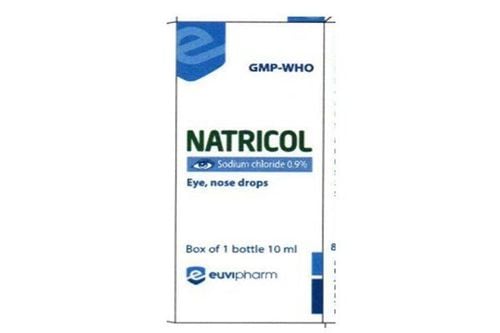This is an automatically translated article.
A perforated nasal septum can make your nose watery or runny, and even bleed profusely. So the nasal septum is perforated, is it dangerous? The following article will provide more information about perforated nasal septum and how dangerous it is.1. What is a perforated nasal septum?
Our two nasal cavities are normally separated by a septum. The nasal septum is made up of bone and cartilage, which helps to circulate air in the nose. The septum can be damaged in a number of ways, leading to complications.A common type of injury to the septum is when a hole develops in it. This is called a perforated nasal septum. It can cause symptoms that vary from mild to severe. Usually, the symptoms of a perforated nasal septum will depend on the size of the hole in that septum.
There are many treatments for a perforated nasal septum, such as home remedies, prosthetics, and surgical repair.
2. Symptoms and causes of perforated nasal septum
2.1. Symptoms of a perforated septum The symptoms of a perforated septum vary from person to person. Usually, symptoms will depend on the size of the hole in the septum. They can be classified into 3 types according to size, including:Small (Diameter less than 1 cm) Medium (Diameter 1 to 2 cm) Large (Diameter greater than 2 cm). Your doctor will be able to determine the size of the perforation through some initial examination. You may never know you will have a perforated septum. Many people have no symptoms. Symptoms will vary in severity and may include:
Wheezing through the nose Damaged nose and crusting appearance Feeling of congestion in the nose Nosebleeds Runny nose Pain Headache Headaches unpleasant odor in the nose. 2.2. Causes of Nasal Septum Perforation A perforated septum can happen for a variety of reasons. Some causes of a perforated septum include:
Previous nose surgery Injuries to the nose, such as: Broken nose, congested nose Spraying with steroids, phenylephrine or oxymetazoline using cocaine Taking certain types of chemotherapy Autoimmune disorders, especially wegener's granulomatosis with polyangiitis Certain infections. Some people may also be more at risk of septum perforation, if they frequently work with specific chemicals, such as mercuric fulminate, arsenic, cement, and those used in chromium plating. If you work in these environments, you can reduce your risk of septum perforation by:
Change the chemicals used De-fog chromic acid Use appropriate protective equipment Practice hygiene good. In addition, we can also reduce the risk of a perforated septum by:
Use a humidifier in your bedroom Use a saline nasal spray to wash your nose every day Avoid picking your nose Avoid using cocaine.

Sổ mũi là một trong các triệu chứng của vách ngăn mũi bị đục lỗ
3. Diagnosis and treatment of perforated nasal septum
3.1. Diagnosis Many people may experience no symptoms from holes in their nasal septum. Therefore, there is no reason for us to see a doctor if symptoms are absent or undetected, so the condition is difficult to detect early. You should see your doctor if you suspect a perforated septum or have symptoms of a nose or breathing problem. Physicians may visit in person to make their own diagnoses of the problem, including:Questions about the patient's symptoms, medical history (including previous surgeries and medications the patient takes) as well as their habits (eg, drug use, frequent nose picking) External nasal exam Order one or more procedures to examine the inside of the nose, including : Nasal endoscopy or palpation of the septum Biopsy of a perforation in the nose Laboratory testing can be performed, especially if a medically related cause is suspected. 3.2. Treating a Perforated Nasal Septum Diagnosing a perforated septum will help develop a treatment plan guided by your doctor. Your doctor will treat the underlying cause (if found), relieve symptoms of a perforated septum, and close the hole if possible or necessary. There are many treatments that your doctor may suggest to try to relieve the symptoms of a perforated septum, such as:
Rinse your nose with normal saline Use a humidifier Apply an ointment antibiotic. Another non-invasive method involves using an intranasal prosthesis to close the hole in the patient's septum. This is described as a dummy button. The doctor can insert the plug into the hole in the patient's nose using a local anesthetic. The prosthesis can be a generic sized button or a custom made button for each person's nose. These nodes can seal the septum and may relieve symptoms. There are several types of buttons available that can be removed by the patient daily for cleaning purposes.
In many cases, the doctor may recommend surgery to repair the patient's septum and remove the perforation. Your doctor may be able to fix only a small hole in the septum. This can be a complicated surgery that only specialists can perform. This type of procedure requires general anesthesia and an overnight hospital stay to monitor your condition and recovery. Your doctor will likely cut your nose on the underside and move tissue to fill in the hole in your septum. Your doctor may even use cartilage from your ear or ribs to repair the septum.

Vách ngăn mũi bị đục lỗ rất khó phát hiện vì vậy bạn nên gặp bác sĩ khi xuất hiện các triệu chứng
More severe cases of perforated septum may require prosthetics or surgery. Installing a prosthesis is as simple as seeing a doctor for an exam.
Recovery from repair surgery will take longer. It may take several weeks before you fully recover from surgery, and you may also have a nasal splint for several weeks after the procedure.
3.4. Deviated nasal septum from a perforated nasal septum Another condition that affects the nasal septum is called a deviated septum. This is different from perforated partitions. A deviated septum is described as when the septum is not centered and disproportionately far to the right or left side of the nose. This can cause airway obstruction on one side of the nose and lead to other symptoms, such as nasal congestion, snoring, and sleep apnea. You may have some of the same symptoms as a perforated septum, such as nosebleeds or headaches.
A deviated nasal septum is usually less serious than a perforated septum, but it still needs to be diagnosed and prescribed by a doctor. Correcting a deviated septum is a much simpler process than fixing a chiseled septum. Normally, the deviated septum correction procedure can be done in 1-2 hours and the patient can go home soon after on the day of the procedure.
3.5. Risks associated with perforated nasal septum surgery Anesthesia: Depending on the medication and method of anesthesia used, the patient may have a reaction. This is extremely rare and it is important to discuss your individual risks with the physician in charge of surgery with anesthetics used Infection: In rare cases, a patient may infection after septal perforation procedure. Infections caused by surgery are usually managed with antibiotics during and after surgery. Bleeding: Although rare, patients can experience bleeding after nose surgery. Your surgeon will likely order blood tests to make sure you are healthy enough to undergo the procedure. Your surgeon should also consider all medications and supplements you take to minimize your risk of bleeding. Need for secondary surgery and revision surgery: Depending on the complexity of the surgery and the size of the perforation, multiple surgeries are sometimes needed to ensure the best outcome. Scar (Synechiae) and slow wound healing: Some patients have underlying disease or are more prone to scarring and poor wound healing. It is important to understand these risks before embarking on a treatment strategy. Local reactions: Occasionally, patients may experience local reactions to the ointments, sutures, dressing materials, and nasal packs used during and after surgery. This rarely happens, but can happen. If a patient is allergic to certain materials or adhesives, they should discuss this with their surgeon prior to surgery. change in sensation in the nose (pain or numbness). This is extremely rare and if it happens, it is usually temporary.

Bệnh nhân có thể bị thay đổi cảm giác ở mũi sau khi phẫu thuật vách ngăn mũi bị đục lỗ
Please dial HOTLINE for more information or register for an appointment HERE. Download MyVinmec app to make appointments faster and to manage your bookings easily.
References: Healthline.com, Nycfacedoc.com












